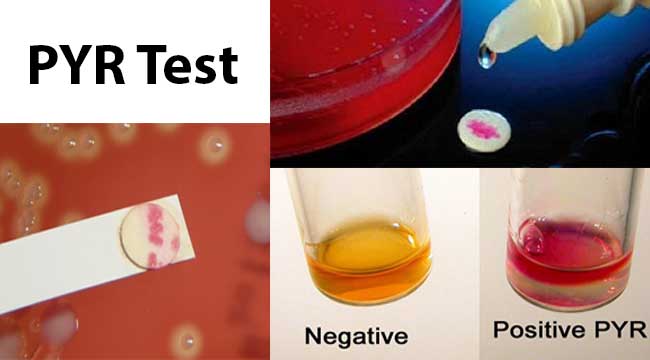
Principle of PYR test:
- L-Pyrrolidonyl Arylamidase (PYR) test is one of the rapid tests employed for the identification of group a beta-hemolytic Streptococci and Enterococci on the basis of activity of the enzyme pyrolidonyl arylamidase.
- It is also termed as pyrrolidonyl aminopeptidase.
- PYR is a bacterial enzyme
- The test disk is impregnated with L-pyroglutamic acid-β-naphthylamide that is hydrolysed by PYR hence serves as a substrate for the detection of PYR
- Hydrolysis of the L-pyroglutamic acid-β-naphthylamide yields beta-naphthylamine which in combination with the PYR Reagent (p-dimethylamino-cinnamaldehyde) forms a bright pink to cherry red colour.
- Either broth assay method or rapid disk method is used for the test.
Procedure:
- Broth Method
- Inoculate PYR broth with 2-5 colonies from overnight (18-24 hours) pure culture.
- Incubate the tube aerobically at 35-37°C for 4 hours.
- Add 2-3 drop of PYR reagent and observe for colour change.
- Observe for the red colour development within 1-2 minutes.
- Disk Method (Rapid)
- With 10 µl sterile distilled water or deionized water, wet the PYR test disc on the strip.
- Note: Do not flood the disk.
- From 18-24 hrs culture, place 5-10 colonies of the tested strain on the surface of the disc with a loop and smear them lightly on it.
- Incubate the disc for 1-2 minutes at room temperature.
- Add 1 drop of N, N-dimethylaminocinnamaldehyde after incubation.
- Observe for red colour development within 1-2 minutes.
Results interpretations:
- Positive test:
- The positive test is indicated by the appearance of bright pink or cherry red color within 1-2 mins. Examples: Citrobacter, Klebsiella etc.
- Negative test:
- The negative test is suggested by no any color change or a blue color because of indole reaction. Examples: Streptococcus bovis, S. equinus
Limitations:
- PYR is only for the presumptive identification of group A Streptococci and group D enterococci from other streptococci thus other tests are recommended for complete identification.
- If the disk or filter paper are too moist, a false-negative test can result.
- Few isolates of lactococci and aerococci maybe PYRase positive.
- If reactions are read after 20 seconds, non-specific color reactions may occur.
